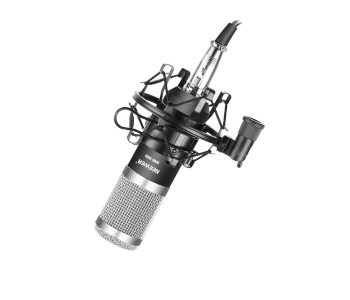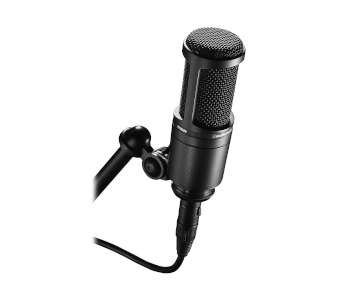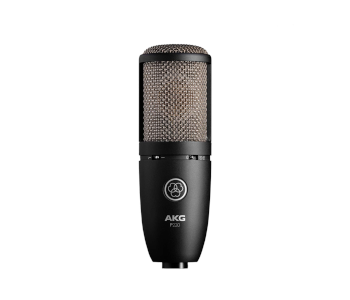8 Best Condenser Microphones of 2019
This page is for you if you’re creating a recording studio. Condenser microphones are incredible instruments for capturing audio. My short introduction looks at the vital buying considerations when choosing a condenser mic. Keep reading if this is all new as it will help you to make better buying decisions. First, let’s go over what a condenser mic is—exactly.
| Budget |
|---|
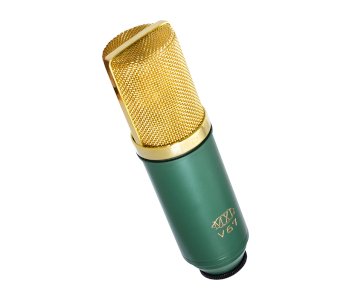 |
| V67G Condenser Mic |
| 4.6/5.0 |
| Power Supply: Phantom 48V |
| Polar: Cardioid |
| Well-built, crystal clear sound, rich midrange, solid-state preamp. |
| Check Amazon |
| Best Value |
|---|
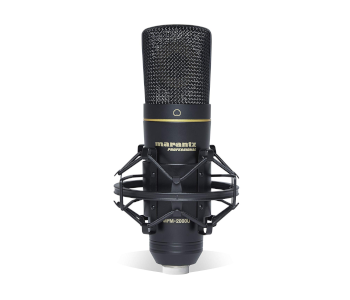 |
| Marantz Studio Condenser Mic |
| 4.7/5.0 |
| Power Supply: Plug-in Device |
| Polar: Cardioid |
| Well built, clear sound, low background noise, sturdy carry case, shock mount. |
| Check Amazon |
| Top Pick |
|---|
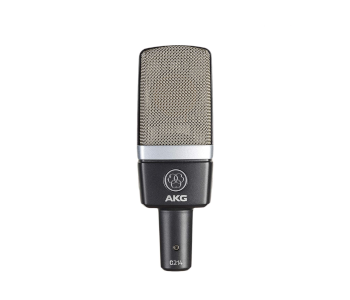 |
| Pro Audio C214 Condenser Mic |
| 4.8/5.0 |
| Power Supply: Phantom 48V |
| Polar: Cardioid |
| Retro look, all-metal build, versatile, low-cut filter, integrated suspension. |
| Check Amazon |
Condenser Mics Defined
Condenser—also capacitor—microphones are the preferred choice for studio work. Dynamic mics, though, are favored for stage performance. I could end it there, but I’m sure you want to know more about the whys and wherefores. So, a condenser mic has a diaphragm, which is an ultra-thin membrane. The membrane moves slightly in response to external sound waves or pressure.
Here’s a quick breakdown of the workings of a condenser microphone:
- Condenser mics have two internal plates positioned close to each other
- Its vibrating front plate is the diaphragm. The back plate is solid brass
- The above arrangement creates the condenser (also called a capacitor)
- A condenser stores an electrical charge delivered by an external energy source
- External energy source can be a power supply, phantom power (see next), or a battery
- The mic’s diaphragm (front plate) vibrates when struck by sound pressure
- These vibrations change the distance between the two plates
- A change in the distance changes the capacitance
- Capacitance is the mic’s ability to store its electric charge
- Capacitance increases when the two plates are close
- Capacitance decreases as the plates move further apart
- A rapidly fluctuating electrical signal imitates the external sound wave patterns
- An external power source then boosts or amplifies the signal so that it’s audible
That’s it. The next must-know point about condenser mics relates to “phantom power.”
Phantom Power Defined
The condenser mics of a bygone age had to use bulky, dedicated external power supplies. These electrical boxes were a hassle to carry around and took up lots of floor space. As technology developed, engineers learned how to make life much simpler. It became possible to transmit direct current (DC) voltage over the mic’s audio cable. It’s what the trade now refers to as phantom power.
One Cable, Two Jobs
The industry calls it “phantom” power because it’s invisible. It shares the same mic cable that carries the audio signal. That means one cable does two jobs. Today, phantom power supplies are often built into preamps, professional mixing desks, and commercial mixers. Phantom power units typically have a voltage range within 12–48V. They’re present on balanced 3-pin XLR locking connectors.
Some microphones work from a 9V supply, and thus use a jack plug instead of XLR connector. All condenser mics show their voltage range on the company’s spec sheet. Always check the voltage to see if your phantom power supply is compatible with the product. Some mics can also get their power from an internal battery that typically lasts for 100+ hours.
Microphone Polar Patterns
The way a microphone hears or picks up sound is its polar pattern. Different patterns hear sound from different directions. That can be front only, front & back, and from all sides equally. Artists choose pickup patterns based on their recording needs. Solo vocals and speech, groups, duets, outdoor recording, interviews, and musical instruments, etc., all benefit from different polar patterns.
Here’s a quick breakdown of the 5 most sought after polar pick-up patterns:
- Cardioid: Most sensitive to sound from the front, least from the back
- Super-cardioid: Sensitivity between a cardioid and omnidirectional pattern
- Hyper-cardioid: More directional than cardioid with less pick-up from the sides
- Omnidirectional: Sensitive to sound from all sides (360° radius)
- Bidirectional (figure-of-8): equal sensitivity from the front and rear
Polar patterns are not all equal, and some makers under or overclaim a product’s pickup sensitivity. The best way to gauge the effect and application of any mic is to read real user feedback.
Types of Condenser Mics
There are 5 types of condenser microphones available, each with distinct qualities:
- Large diaphragm
- Small diaphragm
- Side address
- Dual diaphragm
- Tube Condenser
Large and Small Diaphragm Condenser Mics
Large diaphragm condenser microphones deliver larger-than-life sounds. They’re versatile products used for solo vocalists or solo instruments. They produce rich, warm, and vibrant tones. Small diaphragm condenser mics offer a pure, natural sound with nothing added or taken away. They’re the go-to mics for stringed instruments, drum overheads, and piano.
Side Address and Dual Diaphragm Condenser Mics
Side address condensers are large studio mics addressed from the side rather than the top. They have excellent cardioid pick-up patterns from the front with very little from the back. They’re ideal for vocalists and use with various instruments. A dual-diaphragm mic shares the same configuration as the side-address mic. The difference is the two diaphragms at opposite sides—perfect for duets.
Tube Condenser Microphones
These are classic mics that first came into being back in the 1920s, and still popular today. They use old tube technology instead of transistors, so why are they still around? It’s because they produce a vintage sound that other mics can’t replicate. Their sound is rounded, soft, warm, and musical. Tube condenser mics need a dedicated power supply, preamp, or powered mixer to function.
The Rode NTK Premium is a perfect example of a modern tube cardioid condenser mic.
About My ‘Condenser Microphones’ Guide
Below are reviews for 8 of the current best-selling condenser mics for multiple applications. I considered the opinions of experts as well as user feedback. These microphones are all respected choices for their category. They range from budget-priced entry-level mics through to mid-priced and professional products. My first 3 are Best Budget, Best Value, and the Top Pick.
Soundbars Under $200 Comparison Table
| Make and Model | Power Supply | Polar | Price |
|---|---|---|---|
| MXL V67G Large Capsule Condenser Mic | Phantom 48V | Cardioid | Check Price |
| Marantz Pro MPM-2000U Studio Condenser Mic | Plug-in Device | Cardioid | Check Price |
| Pro Audio C214 Large-Diaphragm Condenser Mic | Phantom 48V | Cardioid | Check Price |
| NW-800 Pro Cardioid Studio Condenser Mic | Phantom 48V | Cardioid | Check Price |
| MXL Mics 770 Cardioid Condenser Microphone | Phantom 48V | Cardioid | Check Price |
| Audio-Technica AT2020 Studio Condenser Mic | Phantom 48V | Cardioid | Check Price |
| Black AKG Vocal Condenser Microphone | Phantom 48V | Cardioid | Check Price |
| Shure Supercardioid BETA 87A Condenser Mic | Phantom 11–52V | Supercardioid | Check Price |
1. V67G Large Capsule Condenser Mic | Best Budget
Editor’s Rating: 4.6/5
The Best Budget condenser microphone goes to the MXL V67G by MXL Mics. It’s an aesthetically pleasing and well-built mic that offers exceptional value for money.
- Best feature 1: Large 32mm condenser capsule
- Best feature 2: Gold-sputtered diaphragm
- Plus points: Well-built, crystal clear sound, rich midrange, solid-state preamp, excellent value
- Minus points: Shock mount not included, not ideal for acoustic guitar
MXL V67G Condenser Mic Highlights
The MXL V67G is a large capsule condenser mic with an affordable price tag. Its gold-sputtered (coated) diaphragm makes the surface a better electrical conductor. An all-metal construction gives the mic a high-quality look and feel. The cardioid pick-up pattern is quite wide and works well for solo vocals and some musical instruments. The sound is clear and has a rich midrange.
Know that the 1.26” microphone capsule can pick up room and background noise. That’s typical of large capsule condenser mics and the reason they work better in sound-treated rooms.
The Not So Good
The MXL V67G condenser mic punches well above its price tag. It does need a shock mount for best results, though, (not included). The MXL 57 Microphone Shockmount is a great choice, or you can opt for a decent third-party alternative. This product is okay-ish for acoustic guitars, but there are better options if that’s your sole purpose. As a vocals mic, however, you can’t beat it for the price.
| Tech Specs |
|---|
| Brand: MXL Mics |
| Mic Type: Large capsule condenser |
| Connection: XLR |
| Polar Pattern: Cardioid |
| Power Supply: 48V phantom (+/- 4V) |
| Maximum SPL: 130 dB |
| Frequency Response: 30Hz to 20kHz |
| Impedance: 200ohms |
| S/N Ratio: 74 dB |
| Product Dimensions: 7.1 x 2 x 2” |
| Product Weight: 20.8 oz. |
| Warranty: 1 year |
| The Pros |
|---|
| Large 32mm condenser capsule |
| Gold-sputtered diaphragm |
| Crystal clear sound |
| Rich midrange |
| Solid-state preamp |
| Well-built and durable |
| Excellent value |
| The Cons |
|---|
| Shock mount not included |
| Not ideal for acoustic guitar |
2. Marantz Pro MPM-2000U Condenser Mic | Best Value
Editor’s Rating: 4.7/5
The Marantz Professional MPM-2000U gets the Best Value slot. It’s a studio condenser microphone with a convenient USB interface, so no phantom power needed.
- Best feature 1: Convenient USB interface
- Best feature 2: Professional specs
- Plus points: Well built, clear sound, low background noise, sturdy carry case, shock mount
- Minus points: Flimsy shock mount, no pop filter
Marantz Pro Condenser Mic Highlights
Mic compatibility: Windows and Mac computers (no drivers needed).
This USB condenser mic by Marantz Professional is perfect as a high-end entry-level microphone. It’s a versatile product suitable for podcasting, studio vocals, and melodic instruments. The sound quality is outstanding when you consider the price of the MPM-2000U. There’s little background noise, zero hiss, a superb low-end, mids, and crisp highs.
The mic bundle includes a sturdy carry case, shockmount, USB Cable, and user manual. You couldn’t ask for more from a condenser mic that falls under the 100 dollar price category.
The Not So Good
The Pro MPM-2000U comes with a shockmount, and it does a good job. But it’s quite flimsy and may break easily with rough treatment. The mic also needs a pop filter (not included). Make sure you get one in advance if you plan to buy the Marantz Pro mic for vocals.
| Tech Specs |
|---|
| Brand: Marantz Professional |
| Mic Type: USB condenser |
| Connection: USB |
| Polar Pattern: Cardioid |
| Power Supply: Plug-in device |
| Frequency response: 20Hz–18,000 Hz |
| Diaphragm thickness: 2μm |
| Body: Solid die-cast build |
| Product Dimensions: 9 x 1.2 x 9” |
| Product Weight: 20.8 oz. |
| Warranty: 1 year |
| The Pros |
|---|
| Convenient USB interface |
| Professional specs |
| Versatile mic |
| Clear sound |
| Well built, robust |
| Low background noise |
| Sturdy carry case |
| Shock mount included |
| The Cons |
|---|
| Flimsy shock mount |
| No pop filter (needs one) |
3. AKG Pro Audio C214 Condenser Mic | Top Pick
Editor’s Rating: 4.8/5
The feature-packed Pro Audio C214 is a large-diaphragm condenser microphone and our Top Pick. This mic is AKG Acoustics’ economical alternative to its industry-leading, high-end C414 family.
- Best feature 1: Large-diaphragm sound
- Best feature 2: Switchable bass-cut filter
- Plus points: Retro look, all-metal build, versatile, low-cut filter, integrated suspension
- Minus points: XLR cable not included
Pro Audio C214 Condenser Mic Highlights
The AKG Pro Audio C 214 has a beautiful retro design. The all-metal construction boasts scratch and shock-resistant properties. Its integrated suspension system helps to reduce vibrations and mechanical noise. These things combined make the C214 a roadworthy product.
This mic is an excellent choice for vocalists. It produces a warm, smooth sound for any gender thanks to the classic large diaphragm. Most owners praise the C214 for its clarity and detail. The mic is ideal for capturing the sounds of musical instruments too, especially guitars. Filters include low-cut and a switchable bass-cut filter. Consider the C214 if you’re serious about quality studio work or stage audio.
The Not So Good
There’s not much negative criticism for the C214. The only gripe—and it’s a minor one—is that it doesn’t include an XLR cable. It’s an inconvenience more than a serious con, though. Make sure you get a quality cable that’s long enough for your needs if you don’t already own one.
| Tech Specs |
|---|
| Brand: AKG Pro Audio |
| Mic Type: Large-diaphragm condenser |
| Connection: XLR |
| Polar Pattern: Cardioid |
| Power Supply: 48V phantom |
| Signal to Noise Ratio: 81dB |
| Pad: -20 dB |
| Low-Cut Filter: @ 160Hz |
| Frequency Range: 20 Hz – 20 kHz |
| Product Dimensions: 6.30 x 2.20” |
| Product Weight: 9.88 oz. |
| Warranty: 3 years limited |
| The Pros |
|---|
| Large-diaphragm sound |
| Switchable bass-cut filter |
| Switchable 20dB attenuator pad |
| Versatile mic |
| Retro style |
| Low-cut filter |
| Durable Construction |
| Scratch and dent-resistant |
| Integrated suspension |
| The Cons |
|---|
| XLR cable not included |
4. NW-800 Pro Cardioid Studio Condenser Mic
Editor’s Rating: 4.2/5
The Neewer NW-800 Pro is an entry-level studio condenser mic and an excellent choice for first-timers. It has an elegant design with a look and feel that suggests it costs more than its price tag.
- Best feature 1: Excellent mic for first-timers
- Best feature 2: Shockproof mount
- Plus points: Plug-n-play, decent audio, bass-reduction switch, anti-wind cap, 8ft XLR cable
- Minus points: Small diaphragm, may need phantom power, not MAC compatible
NW-800 Pro Condenser Mic Highlights
The NW-800 is a plug-n-play microphone. It comes with a 3.5mm XLR cable that you can plug right into a computer and other compatible devices. You don’t have to install drivers either. There’s a lot in the box considering how inexpensive this beginner mic is. The included shockproof mount helps to isolate it against physical vibrations, stand, and floor noise. It’s adjustable and lockable too.
The audio quality is more than acceptable for a mic in its class. There’s a bass reduction switch (-10dB) that does a decent job at reducing any unwanted room noise. The foam ball-type anti-wind cap is also worth mention. It reduces otherwise annoying wind and breath sounds and popping noises. Furthermore, the cap helps to protect the mic and keep it clean.
The Not So Good
The NW-800 Pro is not a condenser mic in the traditional sense. It doesn’t have a large diaphragm typically found in conventional condenser mics. It’s a decent choice for first-timers, but don’t expect the same loud output as those with larger diaphragms. Also, the mic may still need 48V phantom power if your device doesn’t provide enough. It doesn’t work with MAC computers either.
| Tech Specs |
|---|
| Brand: Neewer |
| Mic Type: Studio Condenser |
| Connection: XLR cable |
| Polar Pattern: Cardioid |
| Power Supply: Phantom/plug-in device |
| Product Dimensions: 6.3 x 1.9” |
| Product Weight: 11 oz. |
| Warranty: 1 year |
| The Pros |
|---|
| Excellent mic for first-timers |
| Shockproof mount |
| Plug-n-play |
| Decent audio |
| Bass-reduction switch |
| Foam anti-wind cap |
| 8.2ft XLR cable |
| The Cons |
|---|
| Small diaphragm |
| May need phantom power |
| Not MAC compatible |
5. MXL Mics 770 Cardioid Condenser Microphone
Editor’s Rating: 4.7/5
Consider the 770 cardioid condenser microphone by MXL Mics if you’re testing the water. It’s a good-looking multi-purpose product for use with vocals, stringed instruments, and pianos.
- Best feature 1: Multi-purpose entry-level condenser mic
- Best feature 2: Hard carry case for mic and extras
- Plus points: Portable, beginner-friendly, all-metal body, natural sound, high pass filter, value
- Minus points: Flimsy shock mount, no pop filter, no XLR cable
MXL Mics 770 Condenser Mic Highlights
You get a rugged carry case with foam cutouts for the mic and shockmount with the MXL 770. It keeps the mic protected and makes it easy to transport. Most budget-conscious beginners consider this microphone a reliable product. They appreciate its features, all-metal finish, and patented design. It also gets praise for having a full, warm natural sound for its category.
A flat frequency response guarantees accurate vocal reproduction. The mic’s cardioid pick-up pattern reduces unwanted side noise and suppresses audio feedback. And the high-pass filter ensures no annoying or low-end energy degrades the audio signal. Now add the -10dB pad switch, and you have a condenser microphone that needs no or minimal equalization.
The Not So Good
The included shock mount works as advertised, but it’s quite flimsy and needs handling with care. The hard-shell carry case is a welcome extra, but it too is cheaply made. It does what it’s made for—it’s just that it looks and feels tawdry. The product doesn’t include a pop filter, but it needs one to block plosives, i.e., T, K, P, D, G, and B sounds. It also requires a quality XLR cable (not included).
| Tech Specs |
|---|
| Brand: MXL Mics |
| Mic Type: Multi-purpose condenser |
| Connection: 3-Pin XLR |
| Polar Pattern: Cardioid |
| Power Supply: 48V phantom |
| Maximum SPL: 137 dB |
| Frequency Response: 30Hz – 20kHz |
| Signal to Noise Ratio: 74dB |
| Pad: -10 dB |
| Product Dimensions: 6.22 x 2.32” |
| Product Weight: 16 oz. |
| Warranty: 1 year limited |
| The Pros |
|---|
| Multi-purpose entry-level mic |
| Hard case for mic & extras |
| Patented design |
| Portable bundle |
| Beginner-friendly |
| Sturdy, all-metal body |
| Natural sound |
| High pass filter |
| Excellent value |
| The Cons |
|---|
| Flimsy shock mount |
| Cheap carry case |
| No pop filter |
| No XLR cable |
6. Audio-Technica AT2020 Studio Condenser Mic
Editor’s Rating: 4.6/5
The Audio-Technica AT2020 is a decent studio XLR condenser microphone. It’s a popular choice for home studio work because it provides professional-quality sound without breaking the bank.
- Best feature 1: Clean crisp audio
- Best feature 2: Durable, all-metal yet lightweight body
- Plus points: Popular product, wide dynamic range, high SPL, stand mount, protective pouch
- Minus points: Not ready to use out of the box, weak bass, susceptible to pop sounds
AT2020 Condenser Mic Highlights
You may want to consider the AT2020 XLR mic if you have—or plan to have—a home studio. This microphone has a wide dynamic range and produces pleasing audio. You can expect clean, crisp, sound with low noise. The all-metal construction makes the AT2020 a durable product, yet it only weighs 12 ounces. That makes it comfortable to hold for extended periods and safe to mount on any stand.
The AT2020 has set the standard for durable, lightweight, and affordable microphones. There are a stand mount and a protective pouch in the box to keep the mic clean when not in use. Consider this product if you want to move away from the tinny built-in mics on mobile devices and computers. It guarantees to take the audio of podcasters, YouTubers, and Vloggers, etc., to a new level.
The Not So Good
This microphone is not ready to use out of the box. Make sure you have a stand, XLR cable, and an audio interface if you choose it. You may want a preamp too, though that’s optional. The AT2020’s subpar bass is sure to disappoint users as it’s a little weak compared to some mics.
The mic’s also sensitive to pop, though that’s not unusual. Vocalists and voice actors will need a pop filter (not included), so make sure you have one ready.
| Tech Specs |
|---|
| Brand: Audio-Technica |
| Mic Type: Condenser XLR Studio |
| Connection: 3-pin XLR |
| Polar Pattern: Cardioid |
| Power Supply: Phantom |
| Maximum SPL: 144dB |
| Dynamic Range: 124dB, 1 kHz @ Max SPL |
| Package Dimensions: 9.6 x 9.6 x 2.6” |
| Signal-to-Noise Ratio: 74dB, 1 kHz @ 1Pa |
| Product Weight: 12.1 oz. |
| Warranty: 1 year limited |
| The Pros |
|---|
| Impressive, clear audio |
| Durable, lightweight metal body |
| Popular product |
| Wide dynamic range |
| High SPL (144dB) |
| Includes stand mount |
| Includes protective pouch |
| The Cons |
|---|
| Needs extras; not ready to use out of the box (see review) |
| Bass is quite weak |
| Susceptible to pop sounds |
7. AKG P220 Vocal Condenser Microphone
Editor’s Rating: 4.4/5
The AKG P220 Vocal condenser microphone is an outstanding product for home recording artists. It sports a large 1” condenser and has a solid build that feels as good as it looks.
- Best feature 1: Versatile mic
- Best feature 2: Switchable 20 dB attenuation pad
- Plus points: Reliable, bass roll-off switch, roadworthy, spider shock mount, aluminum case
- Minus points: Heavy (also a pro), few settings, breathy vocals, needs an XLR cable
AKG Vocal Condenser Mic Highlights
The AKG P220 is both versatile and reliable. It works incredibly well for a range of miking applications. That’s why it’s a favorite for many solo vocalists, brass musicians, and acoustic guitarists. It’s ideal for use in a pro or home studio, or front-of-house mixing. There are two main settings for audio control. One is the bass roll-off switch and the other a switchable 20dB attenuation pad.
The bass roll-off switch removes unwanted low-end frequencies or rumble and hum. And the 20dB attenuation pad is useful when you need to cut out background noise. This mic is built like a tank thanks to its heavy metal construction. It also has a thick metal mesh to protect the capsule, which makes it a dependable roadworthy unit. And the robust spider shock mount fits the P220 like a glove.
There’s plenty to like about the AKG P220. A lot of attention has gone into the details. That includes the rock-solid carry case to store and transport the mic, and a two-year warranty.
The Not So Good
This mic is heavy and may prove uncomfortable for some to hold for extended periods. There are few settings which keeps it simple. However, some users may want a product with more controls for better sound manipulation. Some voice artists find the mic a tad ‘breathy’ though they’re a minority. Lastly, there isn’t an XLR cable in the box, but it needs one.
| Tech Specs |
|---|
| Brand: AKG |
| Mic Type: Studio condenser |
| Cable: XLR to XLR (included) |
| Polar Pattern: Cardioid |
| Form Factor: Mount |
| Connector: 3-pin XLR |
| Power Supply: Phantom |
| Signal to Noise Ratio: 78 dB-A |
| Product Dimensions: 9.4 x 8.9 x 5.2” |
| Product Weight: 18.69 oz. |
| Warranty: 2 years |
| The Pros |
|---|
| Versatile mic |
| Switchable -20 dB pad |
| Bass roll-off switch |
| Reliable product |
| Heavy-duty, roadworthy |
| Robust spider shock mount |
| High-quality aluminum case |
| The Cons |
|---|
| Heavy (also a pro) |
| Few settings |
| Breathy vocals |
| Needs an XLR cable |
8. Shure Supercardioid BETA 87A Condenser Mic
Editor’s Rating: 4.5/5
The Shure Beta 87A is a handheld supercardioid condenser microphone. It has an exceptional build quality as with all Shure mics, but is it worth the highish price tag? Let’s take a look.
- Best feature 1: Redesigned with improved handheld comfort
- Best feature 2: Break-resistant swivel adapter
- Plus points: Clear, crisp sound, wide dynamic range, low-frequency roll-off, built-in pop filter
- Minus points: Low output, not ideal for studio use, boring design
Shure BETA87A Condenser Mic Highlights
The BETA87A is a roadworthy stage microphone for speech and vocal applications. This new version has a redesigned, thicker body for improved handheld comfort. Another welcome extra is the break-resistant swivel adapter. And the supercardioid polar pattern does a great job at rejecting unwelcome ambient sounds. The superb detail and clarity make it a wise choice for vocals and speech.
This mic is great for electric guitars. It produces a crisp, crunchy tone with zero muddiness. However, it’s not so good with acoustics. It’s not awful either, but it sounds a tad thin compared to some condenser mics. Still, that also depends on the guitar as some are naturally warm and others are bright. Finally, the Shure BETA 87A is an inexpensive choice for a stage-capable condenser mic.
The Not So Good
The major downside to the Shure BETA87A is that it has low output considering it’s a condenser mic. Also, it’s not an ideal mic for studio use. That’s because its high self-noise at 23.5db is too high. The last con—which is subjective—is the design of this thing. It has to be one of the most boring condenser mics around. Sound is paramount, but mics are also accessories that most folks like to look good.
| Tech Specs |
|---|
| Brand: Shure |
| Mic Type: Stage handheld condenser |
| Connection: XLR |
| Polar Pattern: Supercardioid |
| Power Supply: Phantom 11–52V DC |
| Dynamic Range: 117dB @ 1kHz |
| Frequency Response: 50Hz-20kHz |
| Package Dimensions: 7.56 x 2 x 2” |
| Product Weight: 7 oz. |
| Warranty: 2 years limited |
| The Pros |
|---|
| Redesigned metal body |
| Break-resistant swivel adapter |
| Clear, crisp detailed sound |
| Wide dynamic range |
| Low-frequency roll-off |
| Built-in pop filter |
| Zippered Carrying Bag |
| The Cons |
|---|
| Low output (for a condenser) |
| Not ideal for studio use |
| Boring design |
| No XLR cables |
Contents
- Condenser Mics Defined
- Phantom Power Defined
- One Cable, Two Jobs
- Microphone Polar Patterns
- Types of Condenser Mics
- Large and Small Diaphragm Condenser Mics
- Side Address and Dual Diaphragm Condenser Mics
- Tube Condenser Microphones
- About My ‘Condenser Microphones’ Guide
- Soundbars Under $200 Comparison Table
- 1. V67G Large Capsule Condenser Mic | Best Budget
- MXL V67G Condenser Mic Highlights
- The Not So Good
- 2. Marantz Pro MPM-2000U Condenser Mic | Best Value
- Marantz Pro Condenser Mic Highlights
- The Not So Good
- 3. AKG Pro Audio C214 Condenser Mic | Top Pick
- Pro Audio C214 Condenser Mic Highlights
- The Not So Good
- 4. NW-800 Pro Cardioid Studio Condenser Mic
- NW-800 Pro Condenser Mic Highlights
- The Not So Good
- 5. MXL Mics 770 Cardioid Condenser Microphone
- MXL Mics 770 Condenser Mic Highlights
- The Not So Good
- 6. Audio-Technica AT2020 Studio Condenser Mic
- AT2020 Condenser Mic Highlights
- The Not So Good
- 7. AKG P220 Vocal Condenser Microphone
- AKG Vocal Condenser Mic Highlights
- The Not So Good
- 8. Shure Supercardioid BETA 87A Condenser Mic
- Shure BETA87A Condenser Mic Highlights
- The Not So Good


